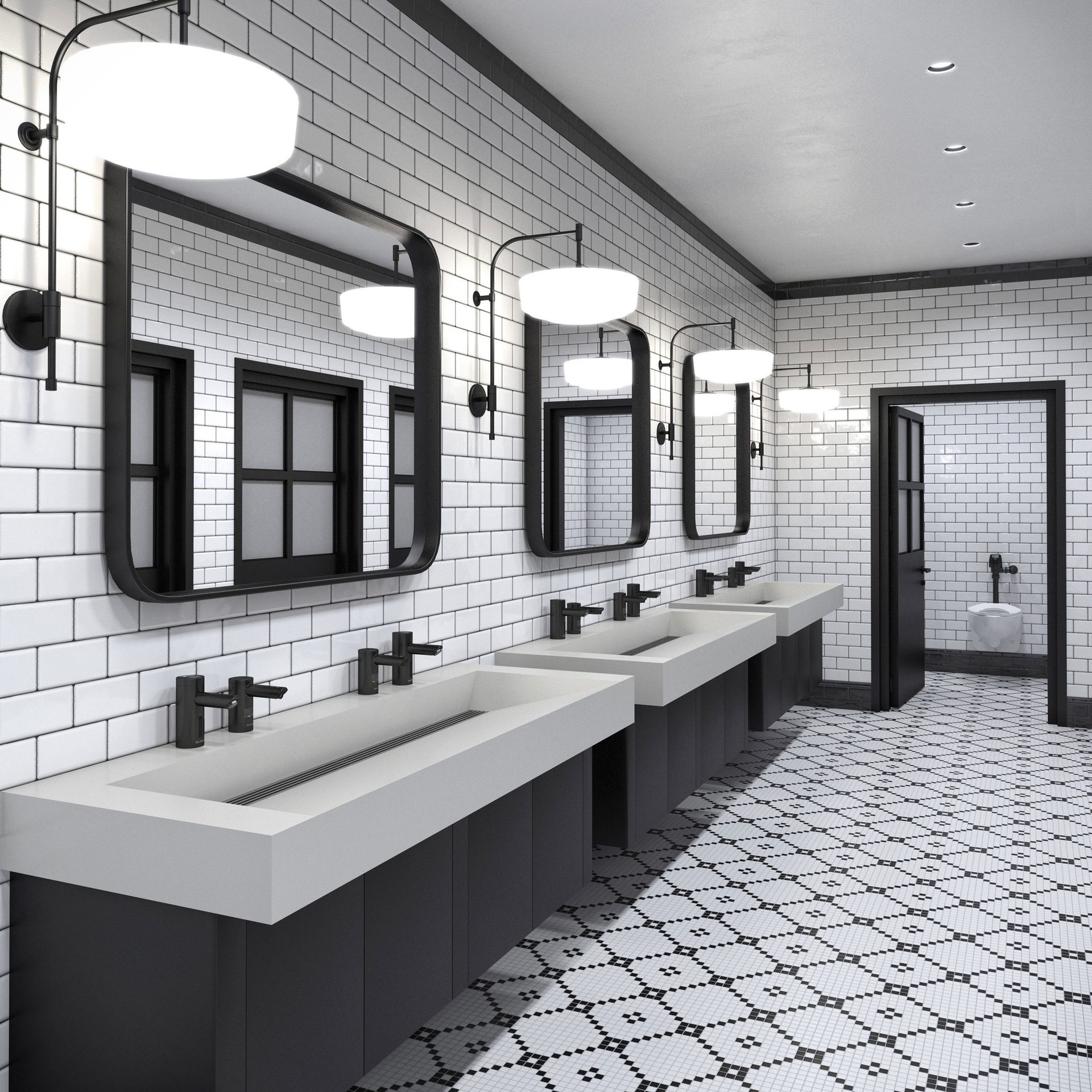commercial
Breaking Barriers: Creating the Restroom for All
Tips for designing accessible, inclusive commercial restrooms.
By: Kim Darke-Miller
Planning for a commercial restroom with all users in mind, regardless of ability, gender or age, makes for a safer, more comfortable restroom that is easy for all occupants to use.
As we move into a more hygiene-focused world, restroom visitors will expect clean, updated spaces that feel welcoming and safe. At the same time, barrier-free, accessible, and inclusive design is putting a greater emphasis on optimizing the planning of commercial restrooms so that they are safe, comfortable, and easy for all occupants to use.
Over the past decade, society has had the chance to rethink discrimination, with growing social awareness of gender identity, differently-abled individuals, and sensory sensitivity. While discrimination based on sex is prohibited and sensory sensitivity could technically fall under the Americans with Disabilities Act (ADA), there are gray areas that must be addressed.
The public restroom is one space that has come under intense fire during this social evolution. A growing number of people identify with a gender they weren’t assigned at birth, and confusion has arisen as to which restroom they should use. Public restrooms can also be very overwhelming for those with sensory processing disorder or other forms of auditory, tactile, and visual sensitivity. Loud hand dryers, flushing toilets, paper towel dispensers, bright lights, and general noise in restrooms can induce anxiety.
Get ahead of the curve
Proximity, privacy and cleanliness are three key considerations when designing restrooms for inclusivity. Universally, people want to feel safe and comfortable in the restroom, so single-occupancy solutions are ideal, as they maximize privacy and flexibility, and allow usage based on gender identity.
However, when single-occupancy restrooms are not feasible, designers can incorporate privacy measures via ambient noise, floor-to-ceiling doors, and amenities within individual stalls, such as paper towels, full-length mirrors, and hygiene products. In addition, all signage should be gender-inclusive, and for added security, each stall should have a visual lock that displays occupancy.
Another option is a hybrid solution that provides single-user options alongside gender-segregated facilities with shared sinks. Facilities can also provide floor-to-ceiling multi-stalls that provide privacy for all users and are available to people of all genders.
When retrofitting a commercial restroom for ADA compliance, it's easy to incorporate IoT-connect products.
We live in an era of changing cultural norms, and providing these options is an excellent way for facilities to get ahead of the changing times. No matter what strategy is used, inclusive restroom design should be built in from the beginning, providing proactive accommodation rather than waiting for issues to arise.
Forward-thinking businesses and organizations that value inclusion will be the change agents. Designers can help in this effort by facilitating discussions with clients and building occupants, helping ensure the evolution of restroom design moves toward a safer and more comfortable environment for all.
A smart experience
As expertise in hand hygiene, water conservation, and accessible design has evolved, manufacturers of commercial restroom products have led the way in developing technologies that decrease the transfer of harmful microbes on surfaces throughout the restroom, conserve water, and meet barrier-free design requirements. Their most important innovation when considering disease mitigation, ADA requirements, and inclusive design is electronic sensing technologies that allow users touch-free operation of restroom fixtures such as faucets, flushometers, soap dispensers and hand dryers.
Electronic plumbing fittings with sensor technology also conserve water and energy, as they flush or dispense water only when the sensor detects a user and can limit water delivery duration. As a result, once guests enter the restroom, they can now go about their business without ever having to physically turn on a faucet, flush a toilet, push a soap dispenser, or tap the hand dryer. This ultimately benefits the health, safety, and wellness of all who visit commercial restrooms.
Changing the game
Sensor technology in the restroom has improved significantly over the years and is continually enhanced to provide advanced operation and more precise sensing. It also has become a significant factor in the Internet of Things (IoT), providing value to clients through smart, connected restrooms.
Sensors in restrooms are the connected technology within fixtures that provide usage data and improve maintenance efficiency by identifying traffic patterns, battery power levels, serial activations, time-since-activation metrics and leak detection. When retrofitting a commercial restroom for ADA compliance, it’s easy to incorporate IoT-connected products that can provide these maintenance and occupancy alerts, track water and energy use, and even allow building managers to track how many people wash their hands after toilet/urinal use, as a correlation can be made between the number of flushometer activations per restroom and number of faucet activations per restroom.

The most important innovation when considering ADA requirements and inclusive designs is utilizing sensing technologies and touch-free experiences.
An example that may help the inclusive community is when a flushometer flushes multiple times within a short amount of time, such as more than three instances in three minutes, it can trigger a maintenance notification to check for a blocked bowl or the IR sensor settings. This reduces the number of unintended/unneeded flushes, saving water, minimizing customer dissatisfaction, and potentially helping those with sensory sensitivity by eliminating unnecessary noise.
In addition, sensors can improve safety and maintenance through smart leak detection and automatic shut-off capabilities to minimize damage caused by a water leak in the restroom system. They can also identify when the restroom floor is wet and notify maintenance, which helps prevent slips and falls in a restroom.
Commercial restrooms designed with accessibility and inclusivity in mind can successfully bridge the gap between practicality and physical, mental, and emotional well-being. Planning for a commercial restroom with all users in mind, regardless of ability, gender, or age, makes for a safer, more comfortable restroom that is easy for all occupants to use.
About the Author
Kim Darke-Miller is Sloan’s senior manager for strategic accounts. Sloan has been providing innovations in water-saving fixtures for 116 years and debuted the first hands-free sensor faucet in 1974.
Photos courtesy of Sloan.




